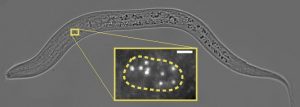C. elegans does not accidentally switch off its ability to detect salt
AMOLF researchers, collaborating with researchers from the Erasmus MC, have discovered a genetic mechanism that ensures that a nerve cell retains its identity once it has differentiated. This concerns a neuron in the worm C. elegans that can detect salt. Its identity is activated by a genetic switch during the cell’s development. Jeroen van Zon and his colleagues have discovered how it is possible that this switch never spontaneously switches off again. The research was published today in the scientific journal eLife.

During the development of an organism, every cell acquires its own identity, such as a muscle cell or nerve cell. Genetic switches in the cell activate that function during the development. An example of such a switch is found in ASE neurons, special nerve cells in the microscopic worm C. elegans that detect salt in its environment.
The switch in ASE neurons is formed by the CHE-1 protein. This protein not only stimulates the production of hundreds of different types of other proteins, which are jointly responsible for detecting salt, but also its own production. Consequently, once it has been activated during the embryonic development, CHE-1 remains permanently present in the ASE neuron – the switch is switched on. Without CHE-1, the microscopic worm is unable to detect salt. It is therefore important that the switch remains activated throughout the animal’s life.
Van Zon and his PhD student Joleen Traets noticed that the production of proteins like CHE-1 can strongly vary in the cell. As a result of that, it should also be possible for the switch to be spontaneously switched off due to chance fluctuations in the cell. “So why doesn’t that happen?” they wondered. Is it a ‘real’ switch? They proceeded to investigate these questions in collaboration with PhD student Ser van der Burght, Suzanne Rademakers and Gert Jansen, a specialist on C. elegans at Erasmus MC in Rotterdam.
Strong connection
Firstly, the researchers demonstrated that a genuine switch is involved.
By using advanced genetic and microscopy techniques, the researchers studied what happens if they remove all CHE-1 from the ASE neuron. If this system is a genuine switch, then they should be able to deactivate it in this manner, and then reactivate it again by reintroducing the protein. If it is not a switch and the protein ensures a permanent change in the cell, then they should be able to remove the protein without the ASE neuron losing its identity and its ability to detect salt. The research revealed that the protein is a genuine switch. Van Zon says that this is the first time it has been demonstrated that such a genetic switch can also be switched off. “What makes this work so striking is that we could use a simple manipulation to make a cell forget its identity, and by doing so, we revealed a major potential weakness in this type of switch.”
Simulation discovers stability
The question remains why this switch stays in the on state with such stability under normal conditions. Computer simulations are one way of investigating that. The computer calculates what would happen if something changed in the cell, for example the concentration or binding strength of the CHE-1 protein.
The calculations revealed that the switch remains activated for an extremely prolonged period if CHE-1 stimulates its own production far more strongly than that of all other proteins responsible for salt detection. In that scenario, if the amount of CHE-1 is very low due to a natural fluctuation in the cell, the production of those other proteins – and so the detection of salt – is temporarily halted to ensure that the production rate of CHE-1 is restored. This is a self-enhancing effect, as a result of which the switch remains on.
Mutant cannot detect salt
After these discoveries, the researchers also demonstrated that the outcomes correspond with the real-life situation. They did this by introducing a genetic mutation in the microscopic worm, as a result of which the protein CHE-1 could no longer properly activate its own production. As expected, in that case, the switch is rapidly and spontaneously switched off and the animal can no longer detect salt.
Van Zon thinks that this mechanism of a stable switch could play a role in other types of cells. “Organisms like mice and people also have this type of switch. That then raises the question whether this mechanism is widely spread. Could our nerve cells also be switched off by removing a single protein? And if that is the case, do they use this mechanism to prevent this from happening during the many decades that these cells live for in our brains? We therefore want to test this idea more widely with other types of cells, first in C. elegans, and later in other animals too.”
Reference
Joleen JH Traets, Servaas N van der Burght, Suzanne Rademakers, Gert Jansen, Jeroen S van Zon, Mechanism of life-long maintenance of neuron identity despite molecular fluctuations, eLife, January 6 (2022).
doi: 10.7554/eLife.66955


